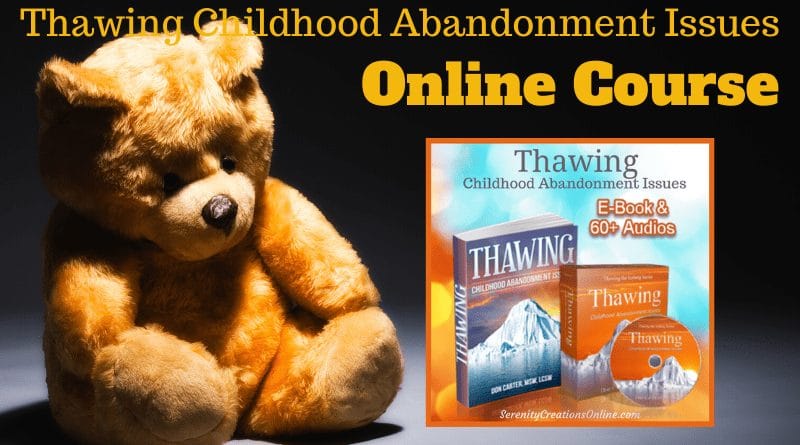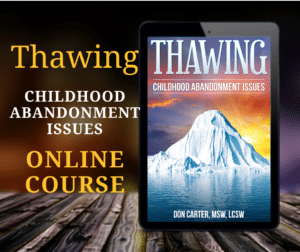
What is a Dysfunctional Family?
A dysfunctional family is a family that does not function in a way that meets the needs of it’s members. It is important to point out that no family functions perfectly all the time, just as no family is dysfunctional all the time. We want to think in terms of mildly, moderately, and severely dysfunctional families for our purposes here.
Growing up on the battleground of a moderate-to-severely dysfunctional family keeps a child on “high-alert.” They are so focused on survival, self-protection, and physical and emotional safety that they rarely have time to settle into just being a kid. When they do let their guard down and relax into their childhood a new incident occurs, which reinforces the need to remain hyper-vigilant. This constant level of alertness keeps the stress response (fight-flight-or-freeze) turned on at the ready. As we will see, living in such an intense state of awareness is fertile ground for the creation of deeply ingrained patterns of behavior known as survival skills.
A Dysfunctional Family as a Battleground
The analogy of a moderate-to-severely dysfunctional family as a battleground: To a small child sleeping in her bed at night, isn’t suddenly hearing mom slamming dishes on the floor while screaming at the top of her lungs, or dad punching holes in the front door while yelling obscenities at mom just as intense as an exploding roadside bomb is to a real soldier? You bet it is. And it can have the same impact if it occurs repeatedly – a mild, moderate, or severe form of PTSD.
The emotional wounding process may be much more subtle than the above example. A child may be forced to wear a pretty dress, with white gloves, and patent-leather shoes all day, every day. She may be allowed to “…go outside, but sit on the porch and don’t get dirty!” by a parent who likes the accolades of having such a well behaved, presentable child – an example of Impression Management rather than healthy parenting.
Alternatively, a child may not be allowed to have his feelings or opinions. The unwritten rules, aka injunctions, might be “Don’t feel,” “Don’t trust,” or “Don’t talk” – in other words, “Don’t be you!” or “Don’t be different than me!” or “Be who I want you to be.”
Frozen Feeling-States
When these kinds of experiences occur early in life, while a child is negotiating the delicate and complicated tasks associated with normal developmental stages, there is a deviation from “normal” development. The child has to learn sophisticated methods of self-protection called survival skills. And the child has no one to rely on to accomplish this learning except their own instinct to survive – i.e., pattern matching and the fight-flight-or-freeze response. These survival skills are learned behaviors that are encoded on the neural circuitry of our brain. They help the child to adapt to the dysfunctional patterns, cycles, and rules of the family.
Information that gets encoded into our brain falls into two primary categories; information having to do with self-preservation (survival) and information having to do with self-actualization (growth). The information has to do with survival is more difficult to access and update than it does with information having to do with growth. One reason for this is because the latter is in a constant state of flux as new learning is occurring daily. This growth-oriented information is stored in the higher cortical regions of the brain, i.e., the “thinking brain.” Survival-oriented data is stored at the deeper emotional and visceral regions where it is immediately accessible to all the structures of the brain responsible for the fight-flight-or-freeze response. The survival systems of the brain are more difficult to update for another reason – the prime directive of the brain is self-preservation. Everything else is deemed less important than that – including growth.
Once a survival skill or experience is learned it becomes tagged as valuable data and must be protected. Think of it as being encoded in an especially secure area of the brain where there is a firewall around it so that hackers can’t get in and change or delete a pattern that may make the difference between life and death. So the survival skills that are learned by a child growing up in a dysfunctional family are rooted in a protected, hard to update area of the brain – immediately accessible to all the structures responsible for the fight-flight-or-freeze response.
One of those structures is the amygdala, the part of the “emotional brain” that is responsible for tagging an incoming experience with feelings. When an incoming experience is similar to that of previous experience that has been categorized as a threat or danger the amygdala sounds an alarm by charging the new experience with fear, anxiety, and/or anger – the feeling-states of the fight-or-flight response. A momentary freeze may occur because the brain needs a second to evaluate the incoming data in order to choose which feeling-state to create if any at all. The chosen feeling-state is then followed by an automatic behavioral response – i.e., fight-or-flight.
Prisoners of War (POW)
Children in a moderate-to-severely dysfunctional family are like prisoners of war – the younger they are the less able they are to outwardly fight back or flee. So when they encounter a new threat, they can get stuck in the freeze response for a lot longer than usual. At such times, a highly sophisticated subconscious defense mechanism can be activated in which the child “zones out” or “goes somewhere else” in their mind while the mind takes care of the business at hand. The clinical term for this is dissociation.
As I explain in my book Thawing the Spirit – Blending Science & Spirituality, while the child is carried off into a fantasy, the subconscious mind continues to process the incoming data, continues to trigger the alarms (increasing in intensity), and continues to search for an appropriate behavioral response. The pre-frontal cortex (thinking brain) comes to the rescue by devising a plan for how to deal with these experiences – creating a survival strategy. If the whole ordeal is intense enough, one-trial learning occurs in the same way as our example of the hunter and saber-toothed tiger. Sometimes the dissociation becomes the survival mechanism creating a dissociative “disorder” – which, at the time it was created, was actually a solution known as a survival skill. We talk about these things on webinars and other Live Events on Serenity Cafe Academy.
Serenity Cafe Academy is designed as a resource for people who can relate to this post. Check it out and Contact Us if you have questions and/or would like some recommendations about where to start.





